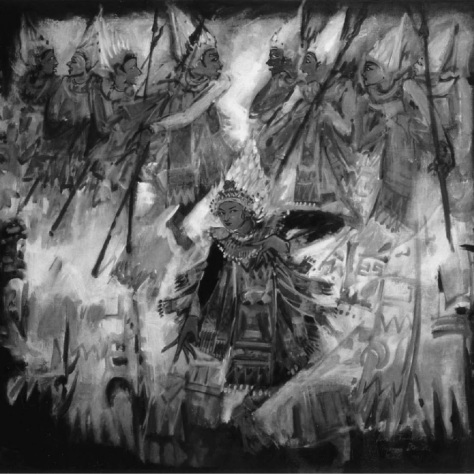Balinese artist Nyoman Darsane was born in 1939 and raised as a Hindu. At age seventeen, he became a Christian and as a result was ostracized by his family and village community. But because he so persistently strove, through his art, to give Christianity a Balinese shape, they eventually decided to accept him back in. They saw that he still loved and respected the culture; he was still “one of them,” even though his religious beliefs took a different turn. Does he feel that, as a Balinese Christian, his identity is divided, that he cannot fully embrace both at once? Not at all. “Bali is my body; Christ is my life,” he says. In other words, Jesus Christ is his all, but can he not pray to and worship and express his love for Jesus Christ in a Balinese fashion? And can he not picture Jesus as a fellow Balinese, incarnate in the skin tone and dress and dance poses of his people?
This is one way that Darsane gives Christianity a Balinese “body”: by giving Jesus a Balinese body, a dancing Balinese body. Dance is an integral part of Balinese culture, and it is intricately tied to religion.
Approximately 95 percent of the people in Bali practice what is known as “Balinese Hinduism” (or “Bali Hindu Dharma”), a unique blend of Hinduism, Buddhism, and ancient indigenous beliefs including animism and ancestor veneration. The Balinese insist that they are monotheistic: they believe in one supreme God (whom they call “Ida Sanghyang Widi Wasa,” or “Sanghyang Widi” for short), but this God has multiple manifestations. They also believe in a spirit realm that exists between the realm of the gods and the realm of human beings. Their rituals, which are frequent and many, are for the purpose of preserving the cosmic balance that exists between the forces of good and evil—which is why they make offerings to both gods and demons.
… But back to dance. The Balinese use dance to worship, petition, channel, and/or entertain the gods, and also to tell stories. Darsane plays upon these functions in his paintings. I’ll focus on just four, each of which casts Jesus in a different role: Creator, Servant, Teacher, Warrior. In all these roles, Jesus can be seen preeminently as Savior: He created the world to be at one with the Godhead, free and at peace and in joy. When that oneness was broken, he descended into the world to restore it. During his earthly ministry, he taught others about God’s will for them, and about how he was the fulfillment of the law and the prophets. Then he fought sin and death head-on, crushing both and making salvation possible for all.
1. Jesus as Dancer-Creator
In this batik painting, Jesus is pictured as the mediator of creation, who dances in front of the Father. Volker Küster, Karel Steenbrink, and Rai Sudhiarsa, in A History of Christianity in Indonesia, describe the painting as follows:
As if at play, the dancing Christ lets the bright ball of the sun glide from his left hand. Spellbound he looks directly into the source of life. In his right hand the sickle of the waxing moon is already extracting itself from a lump of earth. The dancing figure is swinging with his whole body, on the verge of throwing the moon up high. There is no gravity in this movement—it is of great vigor. His white garment of light, a simple loincloth, and his hair blow in the breath of the Spirit. Everything is bathed in the gliding ray of the sun, which makes God’s light radiate over his creation. (943)
Here, Jesus dances creation into being: he bends his knees and unclenches his hand, and out rolls the sun—and he stares into it with such intensity and focus. Unlike the creation stories of a lot of other religions, the Judeo-Christian one teaches that creation was an intentional and loving act of God; the world did not emerge as the byproduct of some unrelated drama or chance phenomenon, but by careful design and direct execution. This differentiation is well-illustrated in Darsane’s painting, in which Christ moves freely but with purpose. God, through Christ (John 1:1-3), laid out the universe and everything in it with the precision and intentionality and spiritual expression of a dancer.
2. Jesus as Dancer-Servant
This painting can be read in two ways: as an Annunciation painting, showing Jesus entering the womb of Mary, who receives him with all humility; or as Jesus’ descent into the heart of the pray-er who confesses faith in him for the first time. In both cases, Jesus “comes down” to dwell with man.
In the painting, Jesus comes bounding down from the top right corner, bringing fire and light. He clears a path for himself, pushing the demons to the edge of the frame so that he can dance right into the heart (or womb?) of the woman who’s inviting him in. This woman sits on her knees, holding a white frangipani up to her forehead, wedged between her fingertips, which is how the Balinese pray. (See pictures here and here, or watch the video below.)
The white flower is only one of several stages of the Balinese prayer ceremony; according to filosbali.net, it expresses worship to the supreme God, who is known through the daily rising of the sun (an article from The Bali Times says that it expresses worship to the sun itself). Other colored flowers are used in prayer as well, each color symbolizing a different manifestation of God. Worshippers hold each flower, one at a time, up to their foreheads as they recite mantras to the accompaniment of bells. When they are done with each flower, they put it in their hair or behind their ear. The closing mantra is recited with open, empty hands. The priest then comes around and pours water into these hands; the worshippers sip the water three times, and then sprinkle some onto their head, face, and neck. They then press grains of rice onto the wet spots, to purify their thoughts and souls and remind them to maintain a prayerful attitude throughout the day.
This communal, ceremonial praying takes place every day in Bali, in the local temples.
Good contextualized Christian art presents Jesus through a given tradition but also as distinct from that tradition in some way; it emphasizes the uniqueness of Christ, but in a visual language that its viewers would understand. Darsane’s painting, for most Balinese, would probably recall the festival Galungan, which occurs every 210 days and lasts for ten days. During this holiday, the Balinese gods and family ancestors visit the earth, but they return to their own realm on Kuningan, the last day of the festival. The distinction with the Christian God is that he came down not to visit, but to live and to die; he came down for thirty-three years straight, and even though he returned to “his realm” after that period, he left his Spirit on Earth to permanently indwell those who call on his name.
3. Jesus as Dancer-Teacher
I’ve been talking all series long about how Jesus’ ministry was and is to draw people into his dance. In this painting, that purpose is illustrated very literally.
A History of Christianity in Indonesia provides helpful commentary:
Christ dances in the center of the picture. All movements are directed towards him. Again he is only dressed with the white garment of light, a traditional sarong, as a sign of his divine descent. His right arm points toward the sky, the palm wide open. The left arm is bent, the open palm pointing toward the left foot raised upward. According to Balinese worldview the right hand belongs to the upper world and the left one to the underworld. In traditional Hindu-Balinese dance this gesture therefore signals redemption. (944)
Here, Jesus preaches by dancing—which is very Balinese of him. He is shown as an outsider (notice his different skin tone) who respects and speaks through the Balinese culture, using his body to teach rather than his words. The islanders naturally flock to him—men, women, and children alike.
4. Jesus as Dancer-Warrior
In these two paintings, Darsane depicts Jesus as a baris dancer, preparing for the battle ahead. Baris (literally “warrior formation”) is the name of a traditional Balinese war dance. The dancer’s movements start out as careful and hesitant, but as the dance goes on, he becomes more and more self-assured. This trajectory of feeling is what Jesus most likely experienced the night before his crucifixion: first, fear of what lay ahead, nervousness, questioning, internal crisis, but then ultimately confidence in his power to defeat the enemy, Satan.
In the first painting, Jesus is dancing solo in the foreground, while the enemy approaches with spears from behind. His pose is meditative—he’s generating physical and emotional readiness—in contrast to the chief priest’s minions behind him, who appear anxious and uncentered.
In the second painting, the eight enemy figures form a circle around Jesus, and they dance wildly around him. Remember the criterion for effective contextualized art that I mentioned earlier?—culturally relevant, but distinct? Volker Küster writes in Visual Arts and Religion, “While the solo dancer in the baris is supposed to heat up the warrior’s aggression and direct it against the enemy, Christ is attracting it towards himself” (57). Instead of responding to his attackers with anger and violence, Jesus submits to every blow that is dealt him. This is a different kind of fight, and it requires a different kind of valor. Jesus is attracting the aggression toward himself because he knows that the world’s only hope of salvation and healing is through his sacrificial death (Isaiah 53:5).
The grotesque and frightening face that’s looming over the dance is Rangda, who in Bali is the personification of evil. The demon queen of the leyaks, Rangda bares her predatory teeth and claws. She is relishing this scene of capture. Little does she know that it is all part of God’s redemption plan, and that this is a battle she will ultimately lose.
* * *
Darsane is quite prolific—the above is obviously only a sampling of his work. Other “dancing Jesus” paintings of his include the woman caught in adultery, Jesus with Mary and Martha, The Radiance of God’s Glory, The Last Supper, The Man Who Betrayed, and a scene from the Book of Revelation.







GREAT article, especially the section on Jesus as Dancer-Servant! I’ve never seen anything about the frangipani and the festival of Galungan, so that was a treat. Thanks for your hard work in researching this series, and the excellent commentary and insights.
Pingback: Jesus the Dancer, Part 8: Conclusion | The Jesus Question
Reblogged this on ORTHODOX CITY HERMIT and commented:
I have long been eager to get acquainted with artworks representing Christ and Bible themes by Asian artists. So, I got very excited when I discovered the Asian Christian Arts Association or the ACAA, established in Bali, where Christian artists and theologians from all over Asia meet, exchange ideas and inspire each other. Nyoman Darsane, a Balinese artist who depicts Biblical characters as traditional Balinese dancers, employing various Balinese symbolisms in his images, was one of the first Asian ‘Christian’ artists to attract my attention. Then, I came across Victoria Jones’ post at The Jesus Question about him. Darsane is an incredibly talented painter who masterfully combines the joy of the Gospel with his Balinese culture, and Victoria’s post is thoroughly researched, offers excellent commentary and insights and does him justice!
Pingback: Global Christianity Via the Arts | Azotus Theology & Art